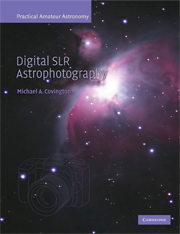13 - Digital imaging principles
Published online by Cambridge University Press: 21 August 2009
Summary
This chapter is a crash course in the principles of digital image processing. For more about most of these concepts, see Astrophotography for the Amateur (1999), Chapter 12.
What is a digital image?
A digital image is fundamentally an array of numbers that represent levels of brightness (Figure 13.1).
Bit depth
Depending on the bit depth of the image, the numbers may range from 0 to 255 (8 bits), 0 to 65 535 (16 bits), or some other range.
The eye cannot distinguish even 256 levels, so 8-bit graphics are sufficient for finished pictures. The reason for wanting more levels during manipulation is that we may not be using the full range at all stages of processing. For instance, a badly underexposed 16-bit image might use only levels 0 to 1000, which are still enough distinct levels to provide smooth tones. An 8-bit image underexposed to the same degree would be unusable.
For greatest versatility, some software supports floating-point data, so that levels can be scaled with no loss of precision; in a floating-point system, you can divide 65 535 by 100 and get 655.35. You can also use large numbers without going out of range; if you do something that produces a value greater than 65 535, it will not be clipped to maximum white.
Note that Photoshop always reports brightness levels on a scale of 0 to 255, regardless of the actual bit depth of the image. This is to help artists match colors.
- Type
- Chapter
- Information
- Digital SLR Astrophotography , pp. 165 - 177Publisher: Cambridge University PressPrint publication year: 2007



